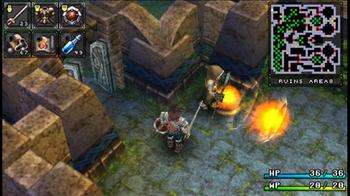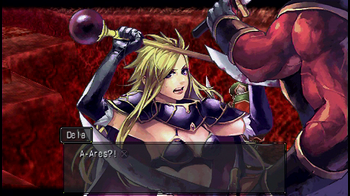
Brandish: The Dark Revenant Review
Originally released in 2009 in Japan, Falcom launched Brandish: The Dark Revenant as a portable remake of the original Brandish title found on the Super Nintendo. While years passed without word of a localization, the game was quickly forgotten as a title not many people were even aware of. At E3 2014, however, XSEED surprisingly announced plans to release this PSP remake, which made its way onto PlayStation Network last week.
At its core, Brandish: The Dark Revenant is an extremely straightforward dungeon crawler. The fundamental mechanics can be grasped within minutes of the start screen.
Similar to other Falcom RPGs, there is a very low barrier of entry in learning how to play the game. Not only is the gameplay easily digested, but the narrative in its entirety would fit in the back-of-the-box blurb (if it had a box). If you were interested in playing a no-nonsense RPG without any bloat whatsoever, then it’s hard to go wrong with Brandish.
You play as Ares, a skilled swordsman with a large bounty for his capture. He is relentlessly pursued by the sorceress, Dela, who is trying to cash in on the bounty. At the start of the game, they both find themselves falling down a large mysterious crevasse in the earth leading to the mysterious underground remains of an ancient kingdom. Simple, right?
The main goal is to navigate numerous maze-like floors to reach to the top of a tower to escape this labyrinth. Rather than a first-person viewpoint like many in the genre, instead, the camera is settled on an aerial viewpoint behind your character as he traverses the grid-like environment. This allows the player to see more of the immediate surroundings as well as enemies and puzzles littering the floors.
With this altered camera angle, combat is done in real-time - no turn-based random encounters here. Enemies also wander the floors of the tower and can attack Ares from both near and far. One-on-one, the idea is simple: face them, block their attacks with your shield, and swing your sword when there is an opening. However, when you start to find interconnected rooms with numerous enemies surrounding you, staying alive becomes a little bit more difficult as you avoid taking damage by sidestepping or jumping.
There are only a few stats to keep note of and they work in straightforward fashion. Strength is how hard you hit, and it is powered up by attacking enemies with your sword. Magic is how potent your spells are, and as you might expect, that improves by casting on enemies. Magic Resistance is self-explanatory and is strengthened by getting hit by magic. HP and MP increase as you gain levels.
With the aerial camera view, much of Brandish revolves not around combat, but around navigating dungeons and solving puzzles. On each floor, you are tasked in finding a way to the stairs to the next floor, which involves finding keys, and avoiding traps.
As you play through Brandish, you will also find yourself filling out your map as you explore. Completing the map to any floor will grant Ares’ a bonus item, which he can either use or sell for money. Getting these bonuses gives you a slight edge in your pocketbook to buy potions or new equipment. Shops are found at various places in the dungeons where you can purchase consumables as well as new weapons, armor, and magic.
Depending on what you are looking for, you might find Brandish to be a little bare. There are only a couple of optional quests, and otherwise, you are generally performing the same task throughout the entirety of the game. You enter a floor, navigate rooms and puzzles while defeating enemies in the way, go for 100% map completion if you’d like, and you go to the next floor and do the same.
Nothing is too complex or difficult here. Enemies are not going to harshly challenge you and survivability is easy to come by. Healing potions are abundant and there is also a ‘rest’ mechanic that allows you to regain health at any time by standing still, but vulnerable, for a moment. You can also save at any time, which makes reloading painless if need be. Puzzles are also largely uncomplicated.
That’s not to say the game isn’t enjoyable to work through. It simply relishes in its simplicity as you spelunk through the mazes. Filling out maps on its own is somewhat of an addicting task. It’s pretty clear that Brandish isn’t trying to be a deep and complex RPG. Instead, it tries to find its niche as a charming and pleasant dungeon romp with solid fundamental gameplay (as well as some great background music).
For those looking for a little bit more of a challenge, after the main story, a second mode becomes available. This is called “Dela Mode”, where, as you might guess from the name, you play as the bounty hunter sorceress instead. Besides some slight differences in attack speed, the game plays identically to the normal game. Unlike Ares’ mode, however, puzzle complexity is ratcheted up significantly, with more dangerous and tricky traps to maneuver.
Dela’s mode, new to the PSP remake, has a lesser number of floors than Ares’s, but it boasts far more complicated puzzles and dungeon layouts. Getting around these floors is perhaps slightly more cumbersome, but requires more actual problem solving and creativity in order to progress from floor to floor.
Clocking in at less than 30 hours for both modes, Brandish: The Dark Revenant works well as an entry into the dungeon crawler genre and doesn't overstay its welcome. It works even better as a portable title due to the simple objectives and the ability to start and stop at any point. Real-time action elements also give Brandish a dash of unique flair. It has its appeal in its directness, but for those looking for a deep and rewarding RPG, you might want to look elsewhere.


